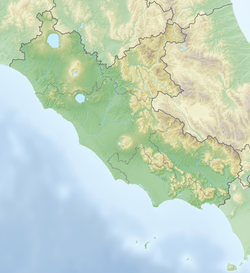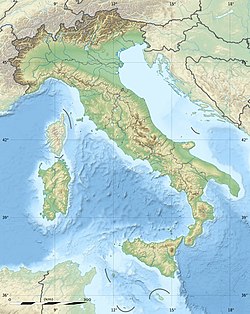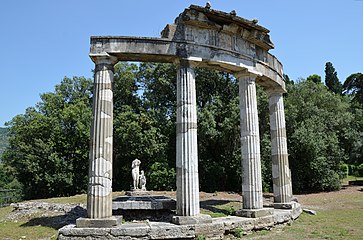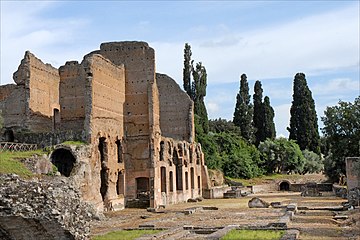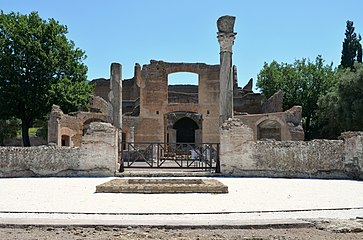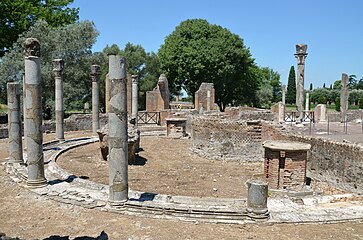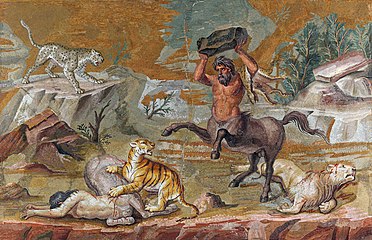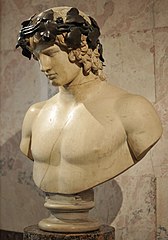Hadrian's Villa
| UNESCO World Heritage Site | |
|---|---|
 | |
| Location | Tivoli, Italy |
| Criteria | Cultural: (i), (ii), (iii) |
| Reference | 907 |
| Inscription | 1999 (23rd Session) |
| Area | 80 ha (200 acres) |
| Buffer zone | 500 ha (1,200 acres) |
| Website | villae.cultura.gov.it |
| Coordinates | 41°56′46″N 12°46′21″E / 41.946004°N 12.772515°E |
 | |
Hadrian's Villa (Italian: Villa Adriana; Latin: Villa Hadriana) is a UNESCO World Heritage Site comprising the ruins and archaeological remains of a large villa complex built around AD 120 by Roman emperor Hadrian near Tivoli outside Rome.
It is the most imposing and complex Roman villa known. The complex contains over 30 monumental and scenic buildings arranged on a series of artificial esplanades at different heights and surrounded by gardens decorated with water basins and nymphaea (fountains). The whole covers an area of at least a square kilometre, an area larger than the city of Pompeii. In addition to the villa's impressive layout, many of the buildings are considered masterpieces of Roman architecture, making use of striking curved shapes enabled by extensive use of concrete. They were ingenious for the complex symmetry of their ground plans and are considered unrivalled until the arrival of Baroque architecture in the 17th century, initiated by Borromini, who used Hadrian's Villa for inspiration.[1]
The site, much of which is still unexcavated, is owned by the Republic of Italy and has been managed since 2014 by the Polo Museale del Lazio.
History
[edit]The villa was constructed near Tibur (modern-day Tivoli) as a retreat from Rome for Emperor Hadrian during the second and third decades of the 2nd century AD. Hadrian is said to have disliked the palace on the Palatine Hill in Rome, leading to the construction of the retreat.[citation needed] It was traditional for the Roman emperor to have constructed a villa as a place to relax from everyday life. Previous emperors and Romans with wealth had also constructed villas (e.g. Villa of Trajan). Though emperors' villas were supposed to be a place of rest and leisure, there is some evidence of Hadrian conducting official duty from the villa in the form of an inscription of an official letter sent from the villa in the summer of 125 AD.[2]
The picturesque landscape around Tibur had made the area a popular choice for villas and rural retreats. It was reputed to have been popular with people from the Spanish peninsula who were residents in the city of Rome.[citation needed] This may have contributed to Hadrian's choice of the property: although born in Rome, his parents came from Spain and he may have become familiar with the area during his early life. There may have also been a connection through his wife Vibia Sabina (83–136/137), who was the niece of the Emperor Trajan. Sabina's family held large land holdings and it is speculated the Tibur property may have been one of them. A villa from the Republican era formed the basis for Hadrian's establishment.[citation needed]. Hadrian began construction on the villa early in his career as emperor, though brick stamp evidence shows us that construction of the villa was ongoing.[3]
During the later years of his reign, Hadrian governed the empire from the villa.[citation needed] He started using the villa as his official residence around AD 128. Therefore, a large court lived there permanently and large numbers of visitors and bureaucrats would have to have been entertained and housed temporarily on site.
After Hadrian, the villa was used occasionally by his various successors (busts of Antoninus Pius (138–161), Marcus Aurelius (161–180), Lucius Verus (161–169), Septimius Severus and Caracalla have been found on the premises).[4] Zenobia, the deposed queen of Palmyra, lived near the villa from 273 until her passing. The villa was restored by Diocletian during the final decades of the third century.[2]
During the decline of the Roman Empire in the 4th century, the villa gradually fell into disuse and was partially ruined as valuable statues and marble were taken away by Constantine the Great and his successors. The facility was used as a warehouse by both sides during the destructive Gothic War (535–554) between the Ostrogoths and Byzantines. Remains of lime kilns have been found, where marble from the complex was burned to extract lime for building material. Building material was also reused by the Christians to build basilicas and other buildings.[citation needed]
The first documented rediscovery of the villa was by Historian Biondo Flavio in the late 15th century who brought its attention to Pope Pius II whose writings on the villa in his Comeratti began to pique architectural interest in the villa.[4] In the 16th century, Cardinal Ippolito II d'Este had much of the remaining marble and statues in Hadrian's Villa removed to decorate his own Villa d'Este located nearby.[3][4] Since that period, excavations have sporadically turned up more fragments and sculptures, some of which have been kept in situ or housed on site in the display buildings.[citation needed]
There were no stratigraphical excavations on most of the site and much information was lost forever. Only from the end of the 19th century have its architecture and functionality begun to be studied scientifically.
Structure and architecture
[edit]
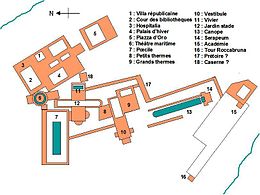
Hadrian's Villa is a vast area of land with many pools, baths, fountains and classical Greek and Roman architecture set in what would have been a mixture of landscaped gardens, wilderness areas and cultivated farmlands. Due to Hadrian's travels, he also commissioned Egyptian style buildings and statues, even naming some of the buildings after Egyptian cities or temples.[citation needed]
The buildings are constructed in travertine, brick, lime, pozzolana, and tufa. Villas were typically sited on hilltops, but with its fountains, pools and gardens, Hadrian's villa required abundant sources of water, which was supplied by aqueducts feeding Rome, including the Aqua Anio Vetus, Aqua Anio Novus, Aqua Marcia, and Aqua Claudia. To avail themselves of those sources, the villa had to be located on land lower than the aqueduct.[5]
The complex of the villa contains many structures from different cultures. For example, the villa has a small river running through it which relates back to the Egyptian Nile river. The villa contains several Greek figures called Poikilos. All surviving written evidence of Hadrian's Villa in ancient writing is from the Historia Augusta, which describes how Hadrian named rooms of the villa after various significant locations within the Roman Empire (the Lyceum, the Academy, Hades) and these continue today to be the terms scholars use to describe sections of the villa.[2]

The architecture goes beyond the mere naming of its structures after places and monuments seen by Hadrian on his extensive travels across the empire. Certain buildings clearly attempt to recreate specific features of landscapes or architecture that had personal significance for the emperor.
Thus, the area known as the Canopus, named after the Egyptian city and a section of the Nile which leads to the city,[2] features a long, stately reflecting pool representing the Nile. It is a large open-air dining area with a covered triclinium with a huge stibadium (a semicircular masonry couch) located in an enormous domed exedra overlooking the lake.[6] This area's sculptural program is the most complete including copies of famous sculptures including the caryatids of the Erechtheion, a statue depicting the Egyptian dwarf and fertility god Bes, and a crocodile.[2][7]
Throughout the canopus, there are many different types of marble seen. The sculptures from the Tiber and Nile gods are made from Parian marble. Pentelic makes up the Caryatids and Telamons. The head of Hadrian of Lunense along with the Amazons and Hermes are made of white Dokymaean.
The Pecile is modeled after the Stoa Poikile in Athens, a city favored by Hadrian. The structures freely mix traditional Greek and innovative Roman elements. The island enclosure (known as the Maritime Theatre) uses the classical Ionic order, albeit in a novel way; the triclinium of the so-called Piazza d'Oro and the Serapeum were covered with Roman segmented concrete domes, probably designed by Hadrian himself.[citation needed]
Hadrian's Pecile located inside the villa was a huge garden surrounded by a swimming pool and an arcade. The pool's dimensions measure 232 by 97 metres (761 by 318 ft). Originally, the pool was surrounded by four walls with colonnaded interior. These columns helped to support the roof. In the centre of the quadriportico was a large rectangular pool. The four walls create a peaceful solitude for Hadrian and guests.[citation needed]
One structure in the villa is the so-called "Maritime Theatre". It consists of a round portico with a barrel vault supported by pillars. Inside the portico was a ring-shaped pool with a central island. The large circular enclosure 40 metres (130 ft) in diameter has an entrance to the north. Inside the outer wall and surrounding the moat are a ring of unfluted Ionic columns. The Maritime Theater includes a lounge, a library, heated baths, three suites with heated floors, washbasin, an art gallery, and a large fountain.[8] During the ancient times, the island was connected to the portico by two wooden drawbridges. On the island sits a small domus, complete with an atrium, a library, a triclinium, and small baths. The area was probably used by the emperor as a retreat from the busy life at the court.[citation needed]
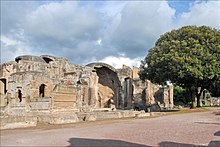
The villa utilizes numerous architectural styles and innovations. The domes of the steam baths have circular holes on the apex to allow steam to escape. This is reminiscent of the Pantheon, also built by Hadrian. The area has a network of tunnels and were mostly used to transport servants and goods from one area to another.[citation needed]
The personal baths of Emperor Hadrian, constructed around 118 AD, were part of his Republican residence and included the innovative Heliocaminus room, which was heated by both sunlight and a traditional hypocaust system. This room featured bakery openings to enhance the heat, serving as a sauna. The hall had a coffered dome with a central opening and large windows facing the south-west. The materials used in the Heliocaminus included marble coatings and stone fillings. The baths feature a unique and complex architectural design, with different types of mortars and concretes used in their construction.
The Antinoeion
[edit]In 1998 a new section of the villa, named by scholars the Antinoeion, was rediscovered.[9] This area is located on the main road leading to the grand vestibule. The discovery of a large concrete foundation has been used as evidence of the original location of the Antinous Obelisk which is now located on the Pincian Hill in Rome.[9] Some scholars have argued that this evidence is proof of Antinous' tomb being located on the villa.[9] This has been challenged by scholars who argue that the area instead was a highly Egyptianized nypheum.[10] The Antinoeion is just one example of Egyptianization of the villa. Artwork such as the crocodile of the Canopus and the statue of Osiris-Antinous show the prevalence of this orientalist aesthetic in the villa.[11]
In September 2013, a network of tunnels was investigated, buried deep beneath the villa; these were probably service routes for staff so that the idyllic nature of the landscape might remain undisturbed. The site housed several thousand people including staff, visitors, servants and slaves. Although much major activity would have been engaged in during Hadrian's absence on tours of inspection of the provinces a great many people (and animals) must have been moving about the Tivoli site on a daily basis.[citation needed]
Sculptures and artworks
[edit]
Many beautiful artifacts have been unearthed and restored at the villa, such as marble statues of Antinous, Hadrian's deified lover, accidentally drowned in Egypt, and mosaics from the theatre and baths.[citation needed] However, not all could be completely restored. The best-preserved pieces of sculptures are usually the ones that get published, but over a thousand fragments remain housed in the villa's Canopus and Cento Camerelle.
A lifelike mosaic depicted a group of doves around a bowl, with one drinking, seems to be a copy of a work by Sosus of Pergamon as described by Pliny the Elder. It has in turn been widely copied.[15]
Many copies of Greek statues (such as the Wounded Amazon) have been found, and even Egyptian-style interpretations of Roman gods and vice versa. Most of these have been taken to Rome for preservation and restoration, and can be seen at the Musei Capitolini or the Musei Vaticani. However, many were also excavated in the 18th century by antiquities dealers such as Piranesi and Gavin Hamilton to sell to Grand Tourists and antiquarians such as Charles Towneley, and so are in major antiquities collections elsewhere in Europe and North America.
Artworks found in the villa include:
- Statue of Osiris-Antinous, Vatican Museum
- Discobolus
- Dove Basin mosaic, copy of a famous Hellenistic mosaic, Capitoline Museums
- Diana of Versailles, Louvre
- Crouching Venus
- Capitoline Antinous
- Young Centaur and Old Centaur (Capitoline versions)
Present-day significance
[edit]The United Nations Educational, Scientific and Cultural Organization (UNESCO) designated Hadrian's Villa as a World Heritage Site in 1999. The designation specified the boundaries of the site and created a buffer zone around it in which no new construction was permitted. In 2011, the communal government of Tivoli announced plans, later cancelled, to build a waste dump in the vicinity of the villa and approved the construction of public housing on 120,000 sq. meters within the buffer zone. At its 36th Annual Meeting, UNESCO formally addressed these encroachments on the site. While they commended the Italian government for its decision to abandon the construction of a waste dump in the Corcolle area, the committee requested the government "to inform the World Heritage Centre in due time about any major development project planned in the buffer zone of the property, including the housing development at Comprensorio di Ponte Lucano, for which a Heritage Impact Assessment should be included, in accordance with Paragraph 172 of the Operational Guidelines, before any irreversible commitment is made." UNESCO also requested "the State Party to submit . . . an updated report on the state of conservation of the property," by February 2014, reflecting concerns over the deterioration of the exposed ruins.[16]
The reasons for making the villa a World Heritage Site are: it is a masterpiece that brings together the material culture of the Mediterranean world, it inspired the Renaissance and baroque period, it inspires the modern world as well, and the villa is an exceptional survival of the early Roman Empire.[17]
In 2016, as part of the reorganization of the Ministero per i Beni e le Attività Culturali, Hadrian's Villa, the neighboring Villa d'Este and the Temple of Hercules in Tivoli were placed under the supervision of the newly created Istituto Autonomo di Villa Adriana.[citation needed]
The Accademia Adrianea di Architettura ed Archeologia1 issued a call for papers for a conference titled Designing the UNESCO Buffer Aobe.[citation needed]
The Academy of the villa was placed on the 100 Most Endangered Sites 2006 list of the World Monuments Watch because of the rapid deterioration of the ruins.[citation needed]
In 2019, UNESCO designated Hadrian's Villa as a site with special immunity from wartime activity due to its profound symbolic value.[18] This added level of security prohibits U.N. members from attacking the site or using it for military purposes in the event of a war.[citation needed]
In 2021 February, archaeologists led by researcher Rafael Hidalgo Prieto from the Pablo de Olavide University announced the discovery of remains of Hadrian's breakfast room which used to show his imperial power. They revealed a structure as a water triclinium and a separate dining room that served as a model for the well-known Serapeum.[19][20]
"The emperor wanted to show things that would overwhelm the visitor, something that had not been seen anywhere else in the world and that exists only in Villa Adriana" said Prieto.[21][22]
Gallery
[edit]-
The Temple of Venus
-
The Nymphaeum
-
The Maritime theatre
-
The Three Exedras
-
The Casino
-
"Battle of Centaurs and Wild Beasts" mosaic was made for the dining room of Hadrian's Villa (120–130 AD). Altes Museum Berlin, Germany
-
Bust of Antinous Hermitage Museum
See also
[edit]- List of Roman domes
- History of Roman and Byzantine domes
- Villa Romana del Casale ruins of a Roman senators villa
References
[edit]| External videos | |
|---|---|
 | |
- ^ Jacobson, David M. "Hadrianic Architecture and Geometry." American Journal of Archaeology 90, no. 1 (1986): 69–85. https://doi.org/10.2307/505986.
- ^ a b c d e MacDonald, William L. (1995). Hadrian's villa and its legacy. John A. Pinto. New Haven: Yale University Press. ISBN 0-300-05381-9. OCLC 30734581.
- ^ a b Boatwright, Mary Taliaferro (1987). Hadrian and the city of Rome. Princeton, N.J.: Princeton University Press. ISBN 0-691-03588-1. OCLC 14966401.
- ^ a b c De Franceschini, Marina (2016). Villa Adriana, Accademia : Hadrian's secret garden. Pisa. ISBN 978-88-6227-827-0. OCLC 965347614.
{{cite book}}: CS1 maint: location missing publisher (link) - ^ "The Emperor's Abode: Hadrian's Villa". Italia. Archived from the original on 26 October 2021. Retrieved 3 November 2015.
- ^ Jashemski, Wilhelmina F., Eugenia Salza Prina Ricotti, and John Foss. "Preliminary Excavations in the Gardens of Hadrian's Villa: The Canopus Area and the Piazza d'Oro." American Journal of Archaeology 96, no. 4 (1992): 579–97. https://doi.org/10.2307/505186.
- ^ Kleiner, Diana E. E. (1992). Roman sculpture. New Haven. ISBN 0-300-04631-6. OCLC 25050500.
{{cite book}}: CS1 maint: location missing publisher (link) - ^ "View Article: Hadrian's Villa: A Roman Masterpiece". depts.washington.edu.
- ^ a b c Mari, Zaccaria; Sgalambro, Sergio (2007). "The Antinoeion of Hadrian's Villa: Interpretation and Architectural Reconstruction". American Journal of Archaeology. 111 (1): 83–104. doi:10.1086/AJS40024582. JSTOR 40024582. S2CID 245264948.
- ^ Renberg, Gil (2010). "Hadrian and the Oracles of Antinous (Sha Hadr. 14.7); with an Appendix on the So-Called Antinoeion at Hadrian's Villa and Rome's Monte Pincio Obelisk". Memoirs of the American Academy in Rome. 55: 159–198. JSTOR 41419692.
- ^ Vout, Caroline (2005). "Antinous, Archaeology and History". The Journal of Roman Studies. 95: 80–96. doi:10.3815/000000005784016342. JSTOR 20066818. S2CID 162186547.
- ^ Pratt, Frances; Fizel, Becca (1949). Encaustic Materials and Methods. New York: Lear, pp. 14-15.
- ^ Sartain, John (1885). On the Antique Painting in Encaustic of Cleopatra: Discovered in 1818. Philadelphia: George Gebbie & Co., pp. 41, 44.
- ^ Plutarch (1920). Plutarch's Lives, translated by Bernadotte Perrin, Cambridge, MA: Harvard University Press; London: William Heinemann Ltd., p 9.
- ^ Drabble, Margaret (2009-09-16). The Pattern in the Carpet: A Personal History with Jigsaws. Houghton Mifflin Harcourt. p. 292. ISBN 978-0-547-24144-9. Retrieved 2012-10-24.
- ^ Decisions Adopted by the World Heritage Committee at its 36th Session (WHC-12/36.COM/19), St. Petersburg, 2012, pp. 117-118.
- ^ "Villa Adriana (Tivoli)". UNESCO World Heritage Centre. Retrieved 2020-09-30.
- ^ Rome, Wanted in (2019-02-25). "Enhanced protection for Villa Adriana in Tivoli". Wanted in Rome. Retrieved 2020-09-30.
- ^ "Archaeologists Have Found the Roman Emperor Hadrian's Palatial Breakfast Chamber, Where He Dined Before Servants on a Marble Throne". Artnet News. 2021-02-10. Retrieved 2021-02-13.
- ^ Rome, Philip Willan. "Archaeologists discover table where Roman emperor Hadrian held power breakfasts at foot of Apennines". The Times. ISSN 0140-0460. Retrieved 2021-02-13.
- ^ McGreevy, Nora. "Archaeologists Discover Ruins of Emperor Hadrian's Ornate Breakfast Chamber". Smithsonian Magazine. Retrieved 2021-02-13.
- ^ "Arqueólogos españoles descubren la sala de banquetes más lujosa del Imperio Romano". abc (in Spanish). 2021-02-09. Retrieved 2021-02-13.
- ^ "Hadrian's Villa: A Virtual Tour". Smarthistory at Khan Academy. Archived from the original on October 12, 2014. Retrieved April 30, 2013.
Further reading
[edit]- A. Betori, Z. Mari, 'Villa Adriana, edificio circolare noto come Sepolcro o Tomba: campagna di scavo 2004: breve sintesi dei resultati', in Journal of Fasti Online, www.fastionline.org/docs/2004-14.pdf
- Hadrien empereur et architecte. La Villa d'Hadrien: tradition et modernite d'un paysage culturel. Actes du Colloque international organise par le Centre Culturel du Pantheon (2002. Geneva)
- Villa Adriana. Paesaggio antico e ambiente moderno: elementi di novita` e ricerche in corso. Atti del Convegno: Roma 23–24 giugnio 2000, ed. A. M. Reggiani (2002. Milan)
- E. Salza Prina Ricotti, Villa Adriana il sogno di un imperatore (2001)
- Hadrien: tresor d'une villa imperiale, ed. J. Charles-Gaffiot, H. Lavagne [exhibition catalogue, Paris] (1999. Milan)
- W. L. MacDonald and J. A. Pinto, Hadrian's Villa and its legacy (1995)
- A. Giubilei, 'Il Conte Fede e la Villa Adriana: storia di una collezione d'arte', in Atti e Memorie della Società Tiburtina di Storia e d'arte; 68 (1995), p. 81–121
- J. Raeder, Die Statuarische Ausstattung Der Villa Hadriana Bei Tivoli (1983)
- R. Lanciani, La Villa Adriana (1906)[1]
External links
[edit]- ^ Somers. "Hadrian's Villa: A Roman Masterpiece". University of Washington Honors Program in Rome. Retrieved 3 November 2015.
- Houses completed in the 2nd century
- Ancient Roman buildings and structures in Italy
- Archaeological museums in Lazio
- Buildings and structures in Lazio
- Hadrian
- Museums in Lazio
- Museums of ancient Rome in Italy
- Open-air museums in Italy
- Roman villas in Italy
- Tivoli, Lazio
- Tourist attractions in Lazio
- World Heritage Sites in Italy
- Archaeological sites in Lazio
- National museums of Italy
- Lime kilns in Italy

